Posts Tagged ‘The Last Airbender’
The Last Airbender




The Last Airbender is terrific! Tremendous character depth; intensely personal, believable conflicts; the timeless moral dilemmas of good vs. evil–all played out on a tapestry of intricate mythology and beautiful cinematography. It stands as one of the finest examples of recent media art.
I’m talking about the animated TV series, of course. The movie sucked.
I expected it to be bad, but it surpasses that weak adjective in the way the universe surpasses “big.” This movie was so abysmal, in so many areas, it’s hard to know where to start. But start I shall, for if I can save even one human soul the pain and suffering of watching this, then my work will have achieved its noble purpose.
Plot Summary: The original series, Avatar: The Last Airbender takes place in a world of four nations: the Fire Nation, the Earth Kingdom, the Water Tribes, and the Air Nomads. Each nation has a few talented citizens who can manipulate, or “bend” that element to their will. One person, the Avatar, is able to control all four elements and keeps the world in balance by kicking the butts of anyone who transgresses beyond their borders. Kind of a one-person U.N., but capable of actual results.
A century earlier the Fire Nation, most powerful of the four, attacked the rest of the world. The Avatar was killed and the new Avatar, a young Air Nomad boy named Aang*, became the new Avatar–and vanished. Now, a hundred years later, he is found frozen in an iceberg and revived. Aang sets out to bring the world back in balance by taking down the Fire Nation.
Those two paragraphs seem to represent all that Shyamalan learned about the show before making it. There is no evidence whatever that he watched it.
Note: I had heard that much of the delightful humor of the original series was missing, and it was. But that doesn’t mean Airbender wasn’t funny: in fact, several of us laughed out loud many times–just not when Shyamalan had planned.
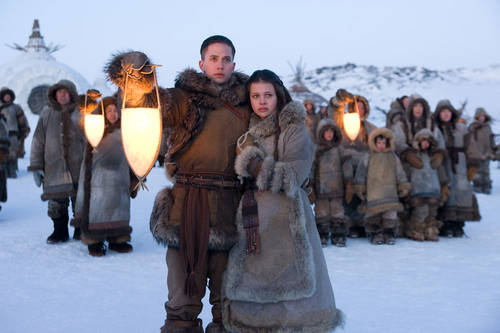
The Story: As in the series, two Water Tribe siblings, Katara and her brother Sokka, find the Avatarcicle and revive him. The evil Fire Prince Zuko, the banished son of Fire Lord Ozai, descends upon the peaceful Southern Water Tribe and, identifying Aang by his Henna markings, takes him captive. Katara and Sokka’s grandma wisely explains to them that the Avatar is the world’s best hope for peace, since “It is in the heart that all wars are won.” Personally, I’ll take superior firepower and tactics, but that’s just me.
Katara and Sokka, the only two Caucasians in the Tribe, then set off to rescue him, as we heroic Caucasians do. Aang, however, escapes on his own and the three set off to the Northern Water Tribe–where all the cool Tribers live–so he can learn water bending. Along the way, Aang learns that he is the last of the Air 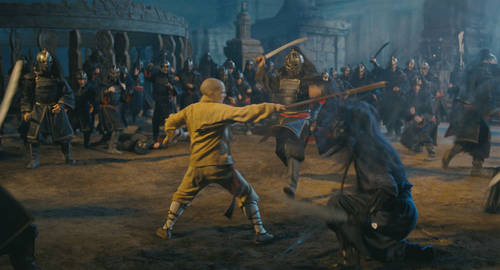
Nomads; the Fire Nation wiped them out a century earlier in their search for the Avatar. Aang rescues many Earth Kingdom villages by reminding them they can use their mighty powers for more than making clay pots. Soon, Aang is rousing them to violence and rebellion. I guess he didn’t get Grandma’s memo about the heart.
Enter another antagonist, Admiral Zhao of the Fire Nation. Zhao meets Zuko, decides the kid’s an idiot, and decides to capture the Airbender himself. Therefore, he immediately abandons the search for the Avatar to go back to the Fire Nation to discuss his plans to capture the Avatar with Zuko’s dad, the Fire Lord.
Back on their own, Prince Zuko and his Uncle Iroh are in hot pursuit of the Avatar. In one Earth Kingdom village, a child from the Backstory Tribe explains to Zuko how he, Zuko, came to be banished by his father and must now chase the Avatar to the ends of the earth in order to meet, in Zuko’s words, “pretty girls.” Oh yeah, and regain his honor and return to the Fire Palace, if it works out.
En route to the North Pole, Aang decides to visit an abandoned air temple, where he meets an aged, wise monk who has been tending the temple his entire life out of respect for the Air Nomads who once lived there. He then turns Aang over to the Fire Nation for a payoff. I guess monkdom has changed in Aang’s absence.
Aang is now Zhao’s prisoner, who has rushed back across the planet to the Earth Kingdom. Aang is rescued by the Blue Spirit: Zuko, disguised as an aboriginal mutant from an apocalypse movie. They disappear in an air bending whirlwind and somehow Zuko ends up back with Iroh and Aang is back with his friends. Maybe it was one of those Wizard of Oz tornadoes or something. I dunno.
At this point, M. Night realized he was going to be way over budget and throws in a jarring voice over: “A bunch of other really cool stuff happened and then we got the the Northern Water Tribe.” Or words to that effect.
Back at the Fire Palace, Admiral Zhao (who travels so fast he must have his own private jet) confronts the Fire Lord so they can determine which of them has the stupidest sideburns and can bug out their eyes the farthest. (Zhao wins both contests.) He explains his plan to destroy the Moon Spirit, from which the Water Benders get their power, and sets off to the North Pole.
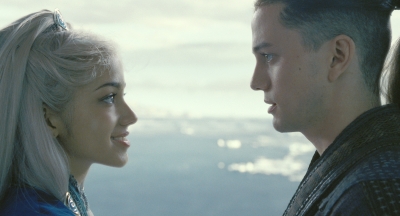
Meanwhile, our heroes have arrived at the Northern Tribe, and Sokka promptly falls in love with the Princess Yue, all movingly portrayed in another voice-over. (Never show when you can tell, eh Night?) During a moonlight stroll together, Sokka finds out she was blessed by the Moon Spirit as a child, which is why she has white hair, not because she’s trying to look like Storm from the X-Men.
Admiral Zhao’s fleet is approaching for the Great Battle. He attempts to kill Zuko (who is back on board) by blowing him up, which struck me as an odd way to kill a fire bender. Sorta like trying to drown a fish. He fails, and Zuko escapes 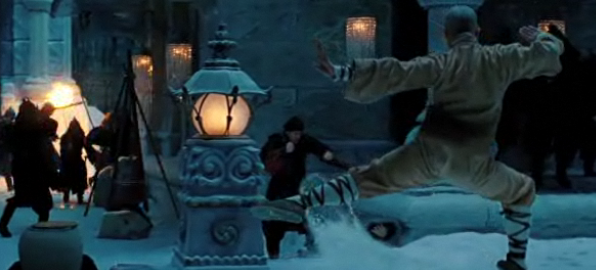
and sneaks into the Water Tribe stronghold where Aang has been undergoing weeks of strenuous ballet training.
Suddenly, ash falls from the sky! The Fire Nation is here! Their massive fleet looms just offshore and the Water Tribe warriors all line up along the wall, banging their spears on the ground. As one they let out their terrifying war cry: “Wooooooooooo.” Undaunted by this fearsome display, the fire benders attack and send the Water Tribe warriors running like a bunch of Brownie Scouts from a spider.
Well, if ever a moment called “Hey Avatar!” this is was it. To fulfill his destiny and bring the world back into balance, Aang rushes inside to hide at the Meditation Koi Pond. He explains to Katara that he needs absolute solitude to meditate. Over Katara’s subsequent cries, of “Aang? Aang? Can you hear me? Hey, Aaaaang!” he talks to some dragon spirit. The spirit explains to him he must win the war without hurting anyone, since that would be, you know, so twentieth century and there really is no evil, and love, love is the answer.
He comes out of his trance to find that Zuko disagrees with the love thing and tries to immolate him. They fight for awhile, then Aang leaves, telling Zuko, “We could be friends.” I think Neville Chamberlain used that same farewell to Hitler.
Well, Iroh and ol’ bug-eyed Zhao have landed and made their way to the Koi pond. Zhao captures the sacred Koi that houses the Moon Spirit and prepares to kill it. Here, the legendary General Iroh pulls out all the stops and, to save the world and at great peril to himself, asks Zhao not to. Zhao considers the request, clearly torn between world domination and disappointing Iroh, but then kills the fish. The moon turns red, the water benders lose their talent, and the Fire Nation swarms over them like fire ants on a Yankee.
Well, Princess Yue didn’t get that hair color from Miss Clairol! She lays down in the pool and her life force is sucked out by the dead fish. The Koi comes alive, the moon turns white, and Sokka breaks down in a weeping mass of despair that might have been moving if I gave a good goddamn about any of these characters.
Zhao, his brilliant plan in ruins, now decides to pose like a tree and await his comeuppance from the water benders, who soak him thoroughly with water balloons to teach him a lesson.
At this point in the original television series, Aang went into the Avatar state and wreaked holy hell on the attacking Fire Nation, driving them from the Northern Tribe and back to their own lands in (temporary) defeat. Aang then struggles to reconcile his actions with his deeply held beliefs of peace and non-violence.
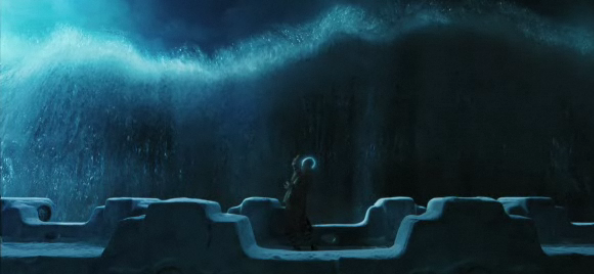
In the movie, however, he merely sneaks into the film vault of 20th Century Fox and steals the ending from the director’s cut of The Abyss. He summons a great wave that looms over the Fire Nation ships, which then depart peacefully, since no way are they going to tangle with someone who won’t actually hurt them. (I wonder how many liberal arts classes Shyamalan took in college.)
Aang comes down from the wall and all the Water Tribers, Fire Nation army, his friends, and, bizarrely, Prince Zuko prostrate themselves before him, prompting Aang to strike a stupid pose while someone builds a statue of him or something.
The credits came up and people cheered. So did I; rarely have I been so happy to see them.
Performances: Noah Ringer as Aang wasn’t horrible. Neither was Nicola Peltz as Katara. Nor was . . . um . . . uh . . .
Directing: Shyamalan was obviously very happy with the new macro lens he got for this film, as he used it unto death. Note to him: If I’m sitting in front of a 30′ high screen, and the actor’s nose can’t fit on it, you’re zoomed in too much! I felt like it was filmed in Mosquito-vision.
I’m sure I’m not alone in wishing M. Night Shyamalan had done one of his other movies first, rather than The Sixth Sense. Then maybe he would never have been trusted behind a camera again. Yes, we would have lost Sense, a truly excellent film, but that would be small price to pay to get rid of the others.
Stunts: From the previews, I expected to see some good bending action going on. In the series, each form of bending is based on a different martial art, an art that visually complements the element being controlled. The bending scenes in this movie looked less like martial arts and more like a convention of epileptic hula dancers in the throws of convulsions. Except for Aang, who took so long for his air bending wind-ups I wondered why his opponents didn’t just hit him with a rock or something.
Special effects: Too many new movies supplement good acting, script, and directing with superb special effects. Well, Airbender didn’t make that mistake. The special effects sucked, too. I’ve seen better effects in fan-made episodes of Star Trek.
Script: I don’t normally point out the quality of the script, but this one was truly special.
“We believe in our beliefs as much as they believe in theirs!”
“I offer my condolences on your nephew burning to death.”
“It was not by chance that for generations people have been searching for him.”
Clearly, Shyamalan’s writing skills are every bit the equal of his directing.
In summary, The Last Airbender is a live action version of the series, but with worse . . . well, everything. Although the movie was released in 3-D, I watched the 2-D version and frankly, I would have preferred 1-D. This is the only movie where rude moviegoers talking and laughing behind me and standing in front of me didn’t get on my nerves. In fact, they were something of a relief.
Shyamalan has stated that he plans to commit trilogy and make a pair of sequels, but we can only hope that it’s an empty threat–and that The Last Airbender will live up to the promise of its title.
All Rights Reserved